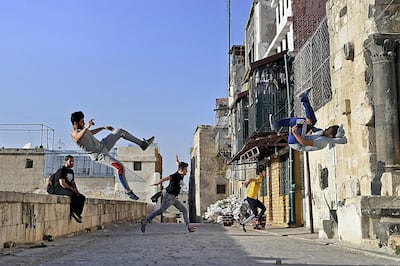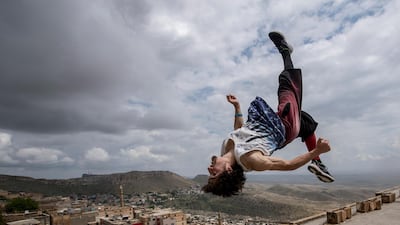Imagine if you were asked to step across two marks that have been chalked on the floor about a metre apart. Assuming you're fit and relatively nimble, it's safe to say that you'd make the distance with no trouble. But now think about doing the same again. Only, this time, the distance isn't marked in chalk but is the gap between two buildings and you're not on the floor but standing 30 metres above the ground. Suddenly, that metre takes on superhuman proportions as you contemplate "leaping" a chasm. And that fear you feel: that is the heartbeat of parkour, one of the 21st century's purest yet most controversial art forms.
You have probably seen parkour (from the French "parcours" meaning "course" or "route") even if you didn't explicitly know what it was. It also goes by its more familiar name "free-running" and was devised in France during the 1980s when traditional military obstacle courses were combined with gymnastics. Using a combination of skill, bravery, and questionable legality, practitioners navigate dizzying "lines" through urban environments. They scale buildings to run across rooftops and make leaps that should break legs. You might think of it as graffiti for the more aerobically fit.
Like many things that begin as a subculture, parkour's styles and attitude have spread into the mainstream. The BBC was one of the first to spot its potential, using it to promote its TV schedule in 2002. In the now infamous ad, the founder of parkour, David Belle, performed a series of unfeasibly high jumps, wall runs, and slides in order to escape his dreary office and to get home to watch his favourite show. As promotions go, it was hugely charming, deceptive, and as cool as skipping school given that the stunts were done across the London skyline to a remix of Dean Martin's Sway.
Parkour's real breakout moment came, however, with the Luc Besson-produced film District 13 in 2004. This time Belle played a detective hunting for a bomb before it destroys part of Paris; a plot that was only really there to hold together a series of spectacular stunts. Parkour clearly suited Besson's punk-orientated view of the world, having appeared in his Taxi 2 (2000) and Yamakasi (2001).
Clip from District 13:
Besson had identified something in the subculture that spoke to wider concerns about urbanisation, privacy, and freedom. Free-running heroes were ultra-chic rebels with runway-model bodies. They accepted no boundaries and ran up, over, and through buildings with no thought to the rules, ownership, or even the physical dangers. It was liberating in a way that movie stunts had never before been. No special effects were needed. It was all about the ingenuity and bravery of the people willing to balance their life on the fine edge of their talent.
From that moment, the influence of parkour was suddenly everywhere, including the 2006 James Bond film, Casino Royale, which begins with a quite memorable showcase of the art. It was especially felt in the world of computer games. The two Mirror's Edge games were pure homage to parkour, which also informed the core mechanic to the Assassin's Creed series. Pretty soon, any game that involved a character running and scaling objects became a game about parkour.
Clip from Casino Royale:
Yet perhaps the greatest advocates of the art remain the free-runners themselves. The names of the collectives might sound strange and exotic – Speeders, the French Freerun Family, and Team Farang – but they have huge followings and their videos routinely make it into the mainstream media. In the last decade, free-running has reached the Arab world, with Parkour Gaza using the unique and challenging architecture of the damaged buildings to create a unique and spellbinding aesthetic. From the UK, meanwhile, the team known as Storror is making videos with high production values, including their full-length documentary, Roof Culture Asia, which they have monetised through Vimeo.
Given the rise of parkour and the extent of its appeal, it's almost disappointing that at some point our admiration for the skills must be qualified by an admission that much of this success has come despite free-running's strained relationship with the law. In 2009, Moreton, on the Wirral near Liverpool, became the first town in the UK to ban parkour. It was followed by Horsham, West Sussex, (perhaps unsurprising given that it's home to Team Storror) and parts of New York.
For all its undoubted beauty, free-running in its purest form requires a resource that is as abundant as it is problematic. It need walls and rooftops and many of those have owners, occupants, and residents who might not take too kindly to young people leaping on and off them. Parkour has responded by looking to become respectable. Purpose-built venues now exist, and the world championships took place this month in Turkey. Yet this has done little to mitigate the central problem. Even as it has evolved, parkour has also devolved. Much of this has to do with the way that Youtube has monetised risky, dangerous, and sometimes unlawful behaviour. "Parkour" has become a catchall word used to describe both the true artists but also the vandals who use it to justify all kinds of trespass.
The problem is, of course, a problem for YouTube whose success has been built upon the back of questionable videos that could not have been made by orthodox means. Commercial producers would not invest in projects based around "freighthopping" where "adventurers" ride across the US or Canada in the gaps between wagons. Nor could they afford the huge legal bills was would result if they encouraged "free climbers" who illegally climb some of the highest structures – towers, cranes, and chimneys – in order to post videos shot from the top.
___________________
Read more:
Palestinians practise parkour on Gaza-Israel border
Learning about the art of calisthenics from the world’s leading practitioners in Dubai
My UAE: Jumping for joy with Emirati parkour coach Amal Murad
___________________
Parkour’s success has certainly been helped by its somewhat outlaw nature, but it also has a better record than many of the other extreme sports. Parkour practitioners are quick to claim what they do isn’t criminal (trespass is usually considered a civil matter) and argue that they leave buildings exactly as they found them. Critics respond by arguing that it’s a misnomer to assume damage isn’t done when feet land where feet were never meant to land. Trespass also takes on a different level of significance when transported to other cultures. What once seemed like youthful arrogance when filmed in London or New York takes on the characteristics of colonial excess when done in India or South America. How does one begin to moralise about art when it involves rich Westerners running on the homes of people whose yearly incomes are far less than the price of the drone being used to film those runs?
Cultural sensitivities might not always be foremost in the free runners' minds, but that is part of the challenge they now face. Parkour at its best can represent a vehicle for a very modern and forward-looking world view. Many of the teams are advocates for their art and sport. They teach it in schools in some of the poorest communities. As free-runner Chris Hayes-Kossmann memorably put it: "One of the main points of the philosophy behind parkour is being able to help people. To teach them to gain confidence in themselves, building up from simple moves to more complex things, to teach them that they are worthwhile people."

And it is here that parkour becomes something more than either art or sport. It becomes a political statement. Those seeking to pit their abilities against true risks are expressing something that has been largely removed from much of western culture. Health and Safety initiatives have made life safer, but at what cost? Smoking bans, cleaner air, and now sugar taxes might do a great deal of good but it also breeds a psychology that makes it hard for some to understand that all life involves risk. Parkour is one place where the reward is ultimately the product of avoiding absolute and terminal failure. As Belle has said: "Obstacles are found everywhere, and in overcoming them we nourish ourselves". It's that nourishment that lies at the heart of what seems from the outside to be crazy and highly irresponsible.
In seeking to turn the entire world into a park, the free-runners are breaking down more than one kind of obstacle. At its worst, free-running is a naive and sometimes transgressive behaviour that amounts to little more than the devilment of a privileged few. At its best, however, parkour faces the world’s walls head on. In seeking to overcome them, perhaps it also spreads a powerful message about individual yearnings for freedom.
Only time will decide which one it ultimately chooses to be.


